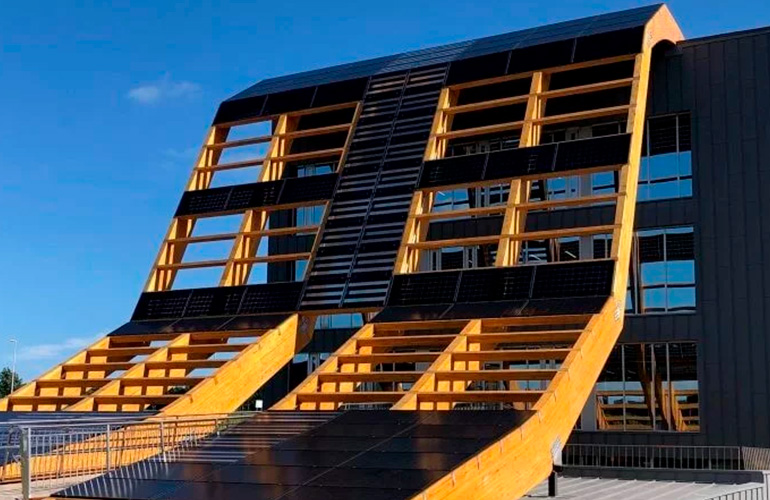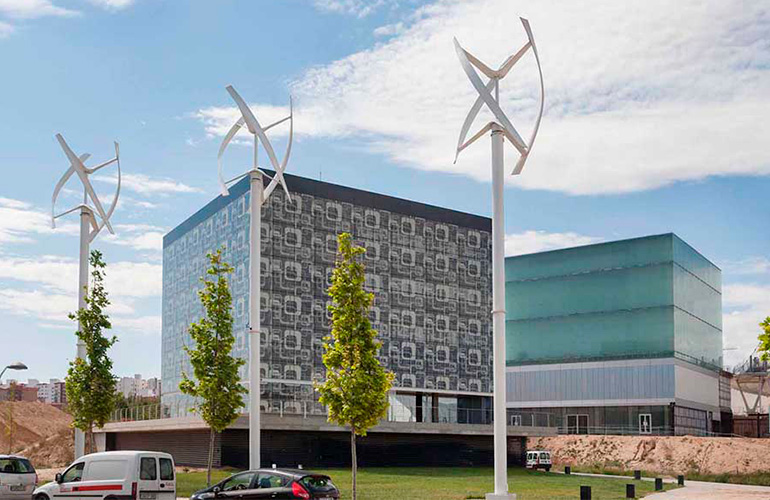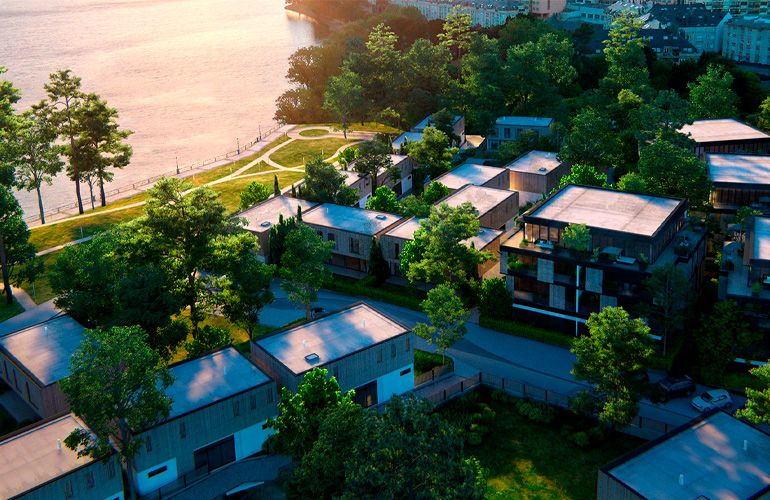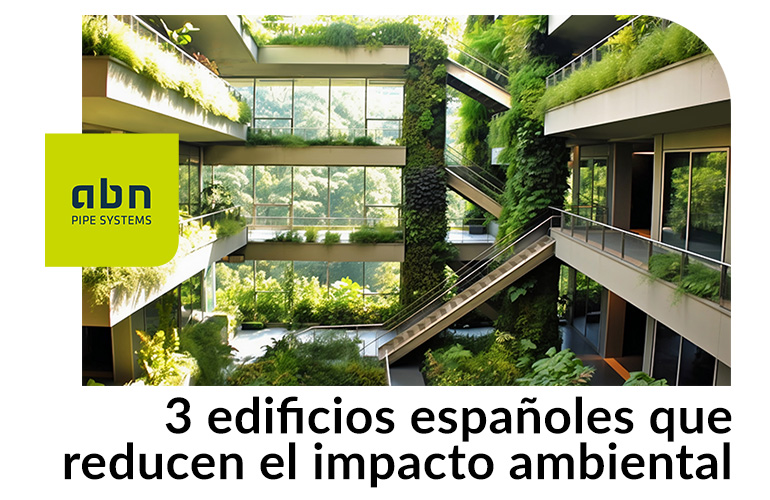La industria de la construcción juega un papel crucial en la economía, pero también es responsable de una parte significativa de los impactos en el medio ambiente: el agotamiento de recursos naturales, la emisión de gases de efecto invernadero o la degradación del entorno natural.
Así, a construcción sostenible es un modelo de edificación que no solo satisface nuestras necesidades presentes, sino que también tiene como objetivo proteger y preservar los recursos naturales para garantizar un futuro mejor.
En este sentido, ofrece un enfoque holístico que abarca desde la planificación hasta la ejecución de proyectos, con miras a minimizar su impacto ambiental y maximizar su contribución al bienestar de las comunidades.
Certificaciones para las construcciones sostenibles
Preservar el planeta es el principal beneficio de la construcción sostenible, pero teniendo en cuenta su implicación en el bienestar humano, son muchas más las razones para impulsar este modelo.
Los edificios que garantizan los estándares de ecoeficiencia y que cumplen con los requisitos de sostenibilidad, logran sellos de verificación como:
- LEED (Leadership in Energy & Environmental Design) es un sistema de certificación de edificios sostenibles, internacionalmente reconocido, que los clasifica en función de su grado de excelencia.
- BREEAM (Building Research Establishment Environmental Assessment Methodology) es una metodología de evaluación y certificación de la sostenibilidad de la edificación que, al igual que el LEED, comprende las distintas fases de diseño, construcción y uso de los edificios.
- Passivhaus es un estándar de construcción que combina un elevado confort interior con un consumo de energía muy bajo, gracias al máximo cuidado de la envolvente del edificio y a un sistema de ventilación controlada.
A continuación, te presentamos tres proyectos diferentes que no solo promueven la sostenibilidad, sino que también son fuentes de inspiración para profesionales del sector que se encuentran en proceso de adoptar prácticas más amigables con el planeta.
Greenspace
El Greenspace, que se ubica en el Parque Tecnológico de Gijón, es uno de los edificios más eficientes del mundo. Se trata de un bloque de oficinas inteligente y bioclimático, que genera más energía de la que consume, vierte el exceso a la red, capta el agua de lluvia para su reutilización y monitoriza sus consumos eléctricos en tiempo real.
Su diseño cuenta con una pérgola fotovoltaica de madera en su exterior como principal elemento distintivo: se trata de una instalación de paneles que generan energía y proporcionan sombra a la fachada sur del edificio.
Posee una instalación de climatización basada en la generación de energía térmica mediante bomba de calor con un sistema de recuperación automática que actúa repartiendo el calor sobrante por las zonas del edificio que más lo necesitan.
Además, combina el uso de suelo radiante en las plantas inferiores y forjados activos en el resto de plantas. Este sistema consiste en insertar tuberías de agua en la propia losa de hormigón aprovechando así la inercia térmica, reduciendo al mínimo la utilización de los equipos de climatización con el ahorro de energía y de gasto económico que ello conlleva.
El edificio, que cuenta con 1200 metros cuadrados distribuidos en sótano, planta baja, dos plantas superiores y cubierta, fue el primero de Asturias en recibir la certificación LEED Oro, que reconoce el diseño de edificios verdes y sostenibles.

Edificio Cero Emisiones
El Edificio Cero Emisiones es un proyecto desarrollado por el Ayuntamiento de Zaragoza y financiado íntegramente por el Gobierno de España a través del Fondo Estatal para el Empleo y la Sostenibilidad (FEESL).
Ha sido diseñado siguiendo parámetros bioclimáticos que le permiten alcanzar un balance neto de emisiones cercano al cero.
La instalación que regula la temperatura se aprovecha de los recursos gratuitos que ofrece el subsuelo, energía geotermia, y por agua, que le llega del Ebro desde una profundidad de 25 metros y por tanto a una temperatura constante de 14 o 16 grados.
Toda la energía que consume en un año procede de energías renovables gracias a la instalación de tres aerogeneradores y placas solares, con una capacidad de producción de 83.500 kilovatios/hora al año. Además, tiene una capacidad de ceder a la red sobrante una potencia eléctrica de 27.000 kilovatios/hora al año.
Consta de 5 alturas, con 2.100 m2 de superficie total construida sobre cubierta, y fue concebido como vivero de incubación de empresas especializadas en tecnologías de la información, en contenidos audiovisual, multimedia, videojuegos y diseño en el ámbito de la innovación y la creatividad en investigación y desarrollo, en agua y energías renovables o en servicios avanzados en los citados sectores.

Urbanización Paraíso Oleiros
Se trata de un conjunto de chalets de lujo que se ubican en Perillo, bañadas por la Ría de O Burgo y rodeada de espacios verdes. Esta urbanización fue la primera de Galicia en obtener el certificado Breeam de sostenibilidad ambiental.
Para su puesta en marcha sus promotores se guiaron por tres parámetros: la construcción sostenible, el respeto ambiental y la eficiencia energética. Así, esta urbanización genera prácticamente toda la energía que consume gracias a la geotermia, la aerotermia y las placas fotovoltaicas.
Además, cuando el consumo de la vivienda no alcanza la producción energética, el excedente se vende a la red general. Esta característica, unida a la instalación de electrodomésticos altamente eficientes y grifería de menor consumo, consigue mejorar en un 80 % el Índice de Eficiencia Energética con respecto a una vivienda convencional.
La urbanización es un espacio cerrado y con acceso controlado de 5.000 m2 de uso comunitario, con dos piscinas, pista de pádel, gimnasio y sala social.

Importancia de un futuro sostenible
Varios de los campos determinados por las exigencias de este tipo de edificación son la arquitectura y el resto de sus disciplinas que intervienen no solo en el diseño del edificio y su construcción sino también en el ciclo de su vida útil y en el de la energía empleada para alimentar dicha construcción.
En este caso, es importante tener en cuenta las nuevas formas de edificación y las normativas que las amparan y promueven, como la EECN y leyes de Calidad de la Arquitectura.
La Edificación de Energía Casi Nula (EECN) impone una nueva manera de construir, alejada del ahorro de costes de fabricación y más centrada en el respeto al medio ambiente y el ahorro energético. Algunas de sus bases son:
- Los edificios deben contar con una muy elevada eficiencia energética. Los materiales y los sistemas de ventilación tienen que garantizar este ahorro en suministros casi total.
- El confort de los usuarios debe garantizarse con unas temperaturas cómodas en interiores sin necesidad del uso de sistemas tradicionales de climatización.
- Las emisiones de CO2 tienen que reducirse casi a cero, ya que es la estrategia principal de la Unión Europea para luchar contra el cambio climático.
Es el caso de la Ley 9/2022, de 14 de junio, de Calidad de la Arquitectura SP/LEG/37672, para consolidar “un nuevo modelo de transición económica, energética y ecológica que promueva una mayor inclusión y cohesión social” en edificios de la administración pública. En este sentido, impulsa un modelo más sostenible de cara al futuro inmediato de la construcción de estos edificios, pese a que todavía queda mucho camino para garantizar la sostenibilidad global.
